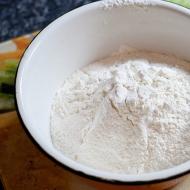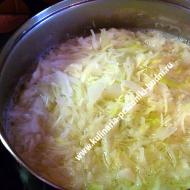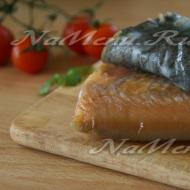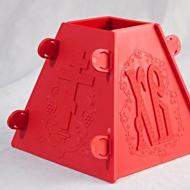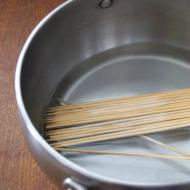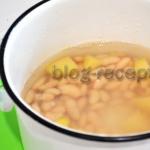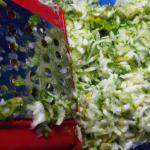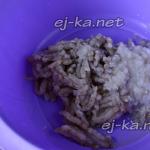
How to salt river fish at home. Salting fish and drying it at home. Salted roach without sugar. Wet and dry method
It is more pleasant to make any dish yourself than to buy it. This rule also applies to salting fish. Often when deciding to cook it yourself, the question arises of how to salt fish for drying correctly. Experienced chefs recommend using 5 basic recipes for salting.
Which fish is suitable for home salting and drying?
The following types are considered optimal:
- vobla;
- crucian carp;
- loach;
- silver bream;
- pike;
- perch;
- goby;
- silver carp.
Freshly caught inhabitants of rivers and lakes are best suited for salting and further drying. Therefore, if there are fishermen in the family who often catch river or lake representatives, salting them will be an excellent solution.
The best way to hang fish is through the gill openings
How to properly prepare fish for salting
There are two types of carcass preparation.
- For big fish. If the carcass is more than 30 cm in length, then it must be gutted. To do this, it is washed, the abdomen is ripped open and the entrails are removed. Then wash everything again in cool water. It is not recommended to cut off the head, but the gills must be removed.
- For small fish. Small carcasses up to 30 cm practically do not need to be prepared. They can be salted ungutted. The only requirement is that the gills must be removed.
If the gills are left, the carcasses will begin to disappear due to the fact that harmful bacteria will begin to develop in them. Even a large amount of salt will not save you from this, because it does not completely disinfect them.
Salting recipes
There are many recipes for salting fish. But not everyone can preserve the taste, as well as give the meat the necessary firmness and fat content.
You can salt fish for drying and subsequent long-term storage in the traditional way, but if you process it and eat it right away, it is better to choose a spicy method.
Dry or traditional method
For this method, you will need a deep wooden container with holes (a box made of boards is best), a linen bag, coarse rock salt and prepared carcasses.
The bag is laid out on the bottom of the box, and salt and carcasses are already laid out on it.
Each fish is well rubbed with salt and placed in a container. You must first pour about 1 cm of salt onto its bottom. The carcasses should be laid so that they lie very tightly. Therefore, it is better to lay them head to tail. Each layer must be sprinkled with a small layer of salt. After everything is laid, salt is poured on top in a 1 cm layer. Place a lid over the contents of the container and press it down with a heavy weight.
Oppression will not allow the formation of air voids in which putrefactive bacteria can develop. In addition, under pressure the meat becomes denser.
Everything stays in this state for about 8 - 10 days in a cool, shaded place. When the juice begins to release on the 3rd – 4th day, it will not linger in the container.
After salting, you can begin soaking and then drying the fish.

This method is suitable for salting large carcasses
Wet method or salting in brine
You can salt fish in this way in a container that does not oxidize (bucket, pan, barrel or tank). To do this, it is placed tightly in a container, belly up, sprinkled with salt (1 kg of salt per 10 kg of prepared carcasses).
To make the meat tender, you can add 20–30 g of sugar.
The lid is placed over the contents of the container and pressed down with a weight. Around day 2, juice will begin to release. It will be mixed with salt and you will get a brine in which the carcasses will remain for about 5 - 10 days. The duration of salting depends on their size.
After this, the fish is taken out and washed in running water. Only after this can you proceed to further drying or drying.
There is another way to prepare brine. To do this, you need to dissolve 1 kg of salt in 3 liters of fresh, filtered water. Afterwards, fresh brine should be poured over the pre-laid carcasses. Afterwards everything is covered with a lid and placed under pressure in a cool place. So they are salted for 4 – 8 days.
Spicy way
You can properly salt fish with spices in the following way. First of all, you need to prepare the brine, as in the previous recipe, and then add bay leaves, black peppercorns, horseradish leaves and ground or grain coriander to it. You can also add sugar to taste.
The fish is placed in an enamel container and filled with brine. After this, it is covered with a lid and pressed down with pressure. She should stay in this state for 2–3 days.
After salting, it should be dried a little. This will allow the meat to acquire a more pronounced taste and increase its shelf life in the refrigerator to several months.
Hanging method
This salting method differs from the previous ones and is only suitable for fatty varieties. The carcasses are strung on a transverse rod through the gill openings and placed in a container with brine so that they are suspended.
To prepare the brine, you only need water and salt. Its amount can be determined using a raw chicken egg or potato. They shouldn't drown in it.
The salting process is slightly different in time and takes only 4 – 6 days. But not everyone knows how many days the carcasses need to be kept in brine, and therefore it often happens that they are overexposed and they manage to gain a lot of salt. In this case, the fish will need to be soaked a little longer than usual and the frequency of water changes will need to be increased to 4-5 times.

After soaking, the fish can be slightly dried or dried.
Salmon method for fresh fish
Mackerel or herring are suitable for this salting.
The fish must first be cut and generously sprinkled with salt in the belly section and on the back. It is recommended to add 10 g of sugar, black peppercorns and bay leaf to taste to the salt. After this, it is wrapped in linen or cotton cloth and placed in the refrigerator.
With this method, the fish must be salted for 30 hours, after which it can be taken out and dried, laid out on a flat surface. However, some people prefer to eat it immediately after salting.
Soaking after salting
If the fish was salted at home using a dry, brine or hanging method, then this procedure is required.
For the rest, before drying, you can simply rinse it (if necessary) under running water.
Soaking instructions.
- For convenience, sort the carcasses by size.
- Large fish are soaked for 1.5 - 2 days. In this case, it is necessary to change the water three times.
- Cool water must be used and the procedure should be carried out in a cool place.
- Small fish are soaked for 24 hours, and the water is changed only 2 times.
- After the procedure, the water must be drained and the fish allowed to flow around.
After these manipulations, you can safely move on to drying or drying.

When soaking, the main thing is to change the water promptly.
What is the difference between dried fish and dried fish?
Not many people know how dried fish differs from dried fish.
In both cases, the fish is first salted and then soaked. The difference is that when drying it is placed in well-ventilated areas with access to sunlight. At the same time, complex processes (physical and biochemical) occur in meat. The peculiarity of dried fish is that after it is ready, it can be immediately eaten without additional processing.
By the way, a dryer for drying fish is best suited for this, but if you don’t have one, you can also use the balcony.
But dried carcasses do not go through the ripening process due to the fact that they are usually dried a little differently. Therefore, such fish is considered a semi-finished product and requires additional processing.
There are many ways to salt fish and they are all suitable for further drying and for drying it at home. The drying process depends on the size of the carcasses and their fat content, and if they do not have time to reach condition within the allotted time, they can always be dried. Salted fish must be additionally steamed and served with boiled potatoes. It perfectly complements the taste of salted, dried or dried fish.
Fish recipes
380 g
15 minutes
225 kcal
5/5 (2)
I offer three basic options for home-salted river, sea and red fish, as well as frozen mackerel and herring. Well, where would we be without herring! I’ll tell you a secret that I haven’t bought ready-made herring for a long time, but make it myself. And it’s no secret that if we salt fish at home, it’s not only simple, but also very tasty.
And now I will tell you about the basic principles of salting river fish - trout and silver carp, sea fish - herring and mackerel, as well as how to salt red chum salmon, pink salmon or salmon. Try these recipes. I think you won't be disappointed.
How to choose the right ingredients
- You can use any fish for salting – frozen sea fish or fresh river fish. The main thing is that the carcasses are whole, not deformed or wrinkled and do not have a yellow tint.
- Buy a product without an ice shell, but only a dry frozen product, so as not to lose weight.
- Salt for brine is taken only coarsely ground, not “Extra” and not iodized.
- You can add any spices you like to the pickling, or you can do without them.
- When pouring cold brine, you can use filtered or cooled boiled water.
Recipe for universal salting of any fish
- Salting time– 7-10 hours.
- Kitchen appliances and utensils: bowl, container with lid, flexible short knife, fish cutting board, kitchen scale, spoon, paper towel.
Ingredients
Step-by-step salting of trout fillet
In this recipe, every moment is important - how to cut the fillet, how long you need to salt the fish and how much salt is needed so as not to oversalt it. I will try to tell you in great detail.
Fillet cutting technique

Preparing the fillet for salting

Finish stage

Video recipe
I suggest you carefully watch a master class on preparing fillets and learn how to properly salt fish from chef Vasily Emelianenko. Each of us will greatly benefit from the advice given in the video.
Recipe for salted (marinated) silver carp pieces
- Preparation time- 20 minutes.
- Salting time- 24 hours.
- Exit– jar, volume 2 liters.
- Calorie content– 101.3 kcal/100 g.
- Kitchen tools: cups, bowl, sharp knife, board, two-liter jar with a nylon lid.
Ingredients
Step-by-step preparation of salted river fish
Another option is how to salt fish at home without boiling the brine.

I often use this “cold” method for salting red fish (mainly chum salmon, salmon or pink salmon). Just before cooking ice cream, red fish fillets must be thoroughly and completely defrosted. To learn how to properly salt river fish, watch the explanatory video.
Video recipe
To watch, I selected a video that clearly demonstrates the process of cold salting of silver carp. Try it too, and then you can leave a review about this recipe.
Recipe for simple salting of whole herring or mackerel
- Cooking time- 20 minutes.
- Salting time– 72 hours.
- Exit– 3-4 pcs.
- Energy content 100 g– 216.7 kcal.
- Kitchenware: board, film, measuring cup, teaspoon, pickling container, container.
Ingredients
Step-by-step preparation of home-salted herring (or mackerel)
In this recipe I present two types of fish - herring and mackerel. The fact is that these two species are almost the same size. Each fish weighs 300-400 g, and most importantly, they can be salted together.

Video recipe
I offer you a story with a detailed demonstration of the process of how to salt fish at home, and very important tips regarding the salting process.
Common truths
- Frozen and even fresh fish is much cheaper than a ready-made, already salted product.
- Self-cooking reliably guarantees the quality of the finished product.
- When vinegar is added to the brine, the fish becomes denser and its meat whiter. But if you like tender, soft pieces, you don't need to add vinegar.
- Salt is an excellent preservative. In 1 tbsp. l. with a slide contains 30-33 g of coarse salt.
- When salted, sugar exhibits the properties of a flavor enhancer.
- To get a more salty product, it is left beyond the time specified in the recipe, and a less salty product is soaked for about an hour and a half in fresh water after the salting time specified in the recipe has expired.
Healthy recipes
Man does not live by fish alone. And with meat products you can appeal just as easily and simply.
- In your spare time, find out how you can quickly salt brisket without spoiling the product.
- Another universal recipe for how to properly salt lard so that it becomes soft. Take advantage of it, especially since the recipe comes with simple and practical tips.
- You can often buy fish with caviar inside. Few people know what to do with it. Be curious so that it differs little from factory production.
- For amateur fishermen, I have selected an extremely necessary recipe -. After all, the fishing season does not stop even in winter.
What kind of fish dishes do you prefer to cook? Share your experiences with us and express your opinion about the recipes I posted. If you liked it, leave your comment, especially if you have something to add and something to say about this. Thank you for your attention to the article and I look forward to your feedback.
3 years ago
5,042 Views
Salted and pickled sea fish rightfully received the status of a royal snack. Not a festive feast is complete without it. Most often, salted or marinated fish is served cut into boneless portions, sprinkled with onions or green onions and drizzled with vegetable oil. There are many salad recipes that include lightly salted sea fish with vinegar, oil or mayonnaise dressing. Every housewife certainly keeps her own secret of preparing herring “under a fur coat”, which decorates the festive table for any family celebration. Of course, you can go to the store and buy ready-made salted herring, mackerel or red fish. But in the industrial production of fish delicacies, chemical flavors, preservatives and dyes are often used. So the ability to salt sea fish yourself will always be useful in everyday life. Using different methods of salting and adding various spices, you can turn the usual herring, anchovy and mackerel into a real delicacy that your loved ones will definitely appreciate.
Salting fish at home
Salting fish at home is not at all difficult, the main thing is to know the basic rules of salting. We will tell you further how to deliciously salt fish at home.
The most common ways to deliciously salt fish at home are dry salting, salting in brine, soaking in brine or marinating.
Dry method Most often, fatty fish of salmon and whitefish species are salted - pink salmon, salmon, chum salmon, taimen, vendace, sockeye salmon, whitefish and others. For salting, filleted fish is sprinkled with a mixture of salt and sugar in a 2:1 ratio. The amount of salt can reach up to 15-20 times the weight of the fish fillet - red fish contains a significant amount of fat and is never too salty. You can also add a little coarse pepper, fresh or dried herbs to the pickling mixture. The salted fillet is wrapped in parchment or placed in a plastic or glass container and placed in the refrigerator. After 3-4 hours, red fish can already be served; this product can be stored in a cool place for no more than five days.

How to fillet a salmon carcass (useful video)
Technology salting in brine (salt solution) is often used for salting small fish - anchovy, sprat or small herring. With this method, the fish is washed, placed in a glass or enamel container and sprinkled with salt (50-100 grams of coarse salt are taken per 1 kilogram of fish). You can also add black and allspice peas, coriander, and bay leaves to the container. Oppression is placed on top. Under pressure, salted fish produces juice, salt dissolves in it and forms brine for salting fish , which serves as a preservative. Fish salted in this way is ready for consumption in 2-3 days and can be stored for up to two weeks.

At home, it is used for salting herring and mackerel. hot or cold pickle with spices – 80-100 grams of salt are added per liter of water. If the fish is hot salted in small pieces, it is ready to serve within an hour, by the time it cools. With cold salting, fish fillets reach perfect condition in about a day.
If you add sugar and acid (vinegar, lemon juice, dry wine or tomato paste) to the saline solution, you will get a marinade. Spices give the marinade a spicy taste - peppercorns, cloves, garlic, bay leaves, coriander seeds, cumin or mustard and others. Herring or mackerel can be marinated whole, filleted or cut into portions.
In a jar with pieces of fish fillet, you can add onions cut into rings, lemon slices or carrot sticks - each time the salted fish will delight you with new flavor shades. The finished fish is stored in a tightly sealed container in the refrigerator for no more than 5-7 days. The higher the salt concentration in the water, the saltier the finished product will taste and the shelf life of the fish will increase.

Here are some proven recipes for delicious marinated fish:
Herring in apple cider vinegar
For this recipe we will need 2 medium frozen herrings and 2 onions. For the marinade – 250 ml water, 2 teaspoons salt and 1 tsp. sugar, 5 tablespoons of apple cider vinegar. Pour water into a saucepan, heat it, dissolve salt, sugar, add spices - peppercorns, a pinch of coriander seeds, a couple of cloves, bay leaves. Bring to a boil and add vinegar. While the brine is cooling, cut the herring into pieces without bones and skin, put it in a jar, sprinkle with onion rings. Pour in the cooled marinade. A day later the snack is ready.

Quick salted fish in two hours
We will need two carcasses of fresh frozen herring or mackerel, one or two onions. For the brine – 400 ml of water, 2 level tablespoons of salt, 2 tbsp. spoons of 9% vinegar, 200 grams of sunflower oil, spices - bay leaf, cloves, a few black peppercorns, a pinch of coriander seeds.
Prepare the brine - dissolve the salt in water at room temperature. We cut the defrosted fish into pieces without skin, remove the bones, put them in a bowl and fill them with the prepared brine, let them sit for two hours. Then drain the brine, place the pieces of fish fillet in a jar, alternating with spices and onion cut into thin half rings. Pour in a mixture of vinegar and vegetable oil, let it brew for another half hour and you can serve, but after a day the marinated fish will become even tastier.

Mackerel or herring in marinade
For this recipe we need two large fatty herrings or mackerel, two onions, half a lemon, several bay leaves, 1 tablespoon of salt, 4 teaspoons of sugar, coarsely ground black pepper.
We clean the fish from bones and skin, cut it into pieces two centimeters wide. Cut the onion and lemon into rings. Place a few onion rings and a bay leaf on the bottom of a liter jar. Next, lay the fish in layers, sprinkling with a mixture of salt, sugar and spices, adding lemon and vegetables until the jar is full. Cover the dish with a lid and leave to marinate in the refrigerator for 2-3 days.

Delicious marinated mackerel
Take three medium-sized fresh frozen mackerel, three onions, three cloves of garlic. We also need 1 tablespoon of salt and 1 teaspoon of sugar, 3 tbsp. spoons of vinegar, and 2 tbsp. spoons of sunflower oil, a few peas of black and allspice, bay leaf.
In this recipe, the fish does not need to be defrosted - it must be quickly cleaned and cut into portions while frozen. Peel the onion and garlic, cut the onion into thin rings and the garlic into slices. Place the pieces of mackerel fillet in a bowl, alternating with onion and garlic. Add salt, vinegar, sugar, spices and oil, mix everything carefully. Then place the fish with the marinade tightly in a glass jar, cover with a lid and put in the refrigerator. In about a day, the mackerel will be salted and ready for use.

There are many recipes for marinades for fish. Try it, change the ratio of salt, sugar and vinegar, add your favorite spices and enjoy the great taste of home-salted fish!
Dessert for today 🙂 - carving - onion lotuses
2016 - 2017, . All rights reserved.
Many housewives practice salting fish at home. This is due to several factors such as quality and price. Factory-salted fish, if you buy it, will be much more expensive. In addition, the quality of such fish leaves the best, and there is not much choice. Almost all the fish at the factory is prepared according to the same recipe. As for homemade pickling, it can be prepared according to any recipe you like. At the same time, quality is always guaranteed if a high-quality original product was used.

It is advisable to use fresh fish for salting, then the quality of the finished product will be the highest. Unfortunately, there is fresh frozen fish on sale, which is also suitable for salting, but you need to choose it correctly. The fact is that it can be frozen and defrosted several times due to some technical reasons.
Each salting method is aimed at preparing a separate type of fish, although each recipe can actually be used for salting any fish and there will be no mistakes here. The main thing is to choose the right ratio of ingredients, depending on the size of the fish.
Everyone wants not to oversalt, although many experts say that it is better to oversalt it and then soak it in cold water for a certain time.
Most recipes are derived from some classic recipe by adding various additional ingredients. And here it is very important that these ingredients do not spoil the taste of the fish. As a rule, the following classic recipe is used for salting fish, based on 100 grams of product:
- Salt – 4 tbsp. spoons, which is about 90 grams.
- Sugar – 1 gram.
- Two carnations.
- 8 grams of pepper (any kind).
- You can add cinnamon, coriander and rosemary.
- Vodka – 90 grams.
Features of salting small fish

For salting, only special glassware or enamelware is used, or, in extreme cases, stainless steelware. Standard salting includes up to 1 kg of fish and 15 grams of salt. For stronger salting, take from 30 to 100 grams of salt. To keep the fish longer, up to 10% saltpeter is added to it, and you can use a wooden box for salting. In this case, the salt concentration should be higher. The salted product should be stored in a cool place, while fish such as sprat, sprat or anchovy are prepared without preliminary cutting.
Before the salting process, the fish is thoroughly washed in cold water, after which it is necessary to remove excess moisture from the glass. After this, it is mixed with salt, and this must be done so that the salt sticks to the entire surface of the fish, after which the fish is placed tightly in a special container prepared in advance.
After placing the fish, it is pressed down under pressure. That is, they take, for example, a wooden circle and place a stone on it. This is necessary so that all the fish can be cooked equally while in the brine. To salt fish in this way, take 1 kg of product, salt, different types of pepper, bay leaf and saltpeter. The fish is salted for 2-3 days. Alternatively, various spices are added to the product, in the form of currant leaves or regular blackberries.
Salting medium-sized fish

For regular but strong salting, you need to take up to 200 grams of salt per 1 kg of the original product. Before this process, the fish is well cleaned, with the entrails removed. At the same time, they use a method when the fish is cut not in the abdominal area, but along the back. After this, the fish is washed in cold but salty water. To do this, take 2-3 tablespoons of salt per 1 liter of cold water. The fish is washed until the water is clean and free of blood.
For salting you will need:
- 1 kg of medium-sized fish.
- 200 grams of salt per 1 liter of water.
- Bay leaf and pepper to taste.
- Cardamom or juniper, depending on the origin of the recipe.
- 1 tablespoon sugar.
- Ginger or nutmeg.
- Rosemary or cardamom (can be combined).
Medium-sized fish prepared using this method should be kept in a cold cellar. On the second day, the juice formed during the salting process is drained, and fresh brine is poured into place. Subsequently, the brine is replaced on the 4th and 6th days. The total cooking time for fish is about 10 days.
After 10 days, the fish is placed in jars and then closed with a tight lid. For storage, the product is placed in a dark, cool place, and before use, it is better to soak it in water for 1 hour.
Medium-sized fish is salted with both strong and medium salting, depending on the specific conditions and tastes of the person himself.
After 10 days of the salting process, the fish can be eaten.

Cooking large fish requires gutting, and even better, if you cut it lengthwise and spread it out, then the quality of cooking will be the highest. In any case, the entrails are removed and the head is removed altogether. An incision is made along the back, and it is advisable to remove the spine and most of the bones. The meat should be wiped with a rag and rinsed with water and then immediately rubbed with salt.
Several types of salting of large fish are used:
- Transport.
- Weak.
- Average.
- Strong.
As a rule, cooking large fish requires a lot of money and time. For regular salting, only coarse salt is used. It allows you to get the most delicious product, and will also allow you to quickly remove moisture from the fish. Coarse salt has the best preservative properties because it does not dissolve as quickly at low temperatures. Before salting, the fish is thoroughly washed and salted, but do not forget to salt the inside of the belly first.
The fish is placed in a specially prepared container with its belly up. A layer of salt is also placed between the fish. The larger the fish, the longer it will take to salt.

Since fresh fish is difficult to obtain, fresh frozen fish is salted and frozen on a fishing boat using the flash freezing method. Therefore, first of all, you need to defrost the fish and do everything correctly. The defrosting process should take place under natural conditions, without forcing this process. To do this, you can put it in the refrigerator overnight.
Only high-quality original products need to be salted. Frozen fish should not have a layer of ice, and there should be no damage to its body. The eyes should be light and the sides should be round and thick. When pressed, the meat should be dense and elastic. If the recipe requires removing the skin, it is better to do this from frozen fish. Then the fish's head and tail are cut off, along with its fins. After this, it is gutted and washed thoroughly. It would be a good idea to remove all the bones with the spine. If the fish carcass is large, then it is better to cut it into pieces weighing 50 grams. After this, the onion is cut and laid on top, with the addition of garlic and spices.
Each piece is salted separately, and the fish is placed tightly in a container. The pieces are sprinkled on top with the same dry mixture, with onions and garlic, as well as seasonings. Finally, the fish is placed in the refrigerator. If you put this fish in the refrigerator in the evening, you can eat it in the morning. Carcasses weighing up to 1 kg can be salted whole. In this case, it is better to remove the head, tail and fins, and also gut it carefully.
Recipes for salting herring

First of all, you should choose quality fish. It is better if it is freshly caught fish, but freshly frozen fish will also work. It is better to choose large and fatty herring carcasses, since after salting they will be the most delicious.
As a rule, the most delicious herring is considered to be Pacific or Atlantic herring, with silvery skin, clear eyes and fins pressed to the body. Such fish is usually salted in jars, placing the fish in them head down and filling it with brine. To prepare the brine, take 1 liter of water, 5 tablespoons of salt, 5 peas of black allspice, sugar and bay leaf.
The herring is filled with cooled but boiled brine, with all the necessary ingredients. Preparing the brine should not cause any difficulties. First, the water is placed on the fire and brought to a boil, after which the necessary ingredients are added to it. After this, the mixture should boil for about 5 minutes, after the fire is turned off and the brine is allowed to cool. After this, the fish is poured with cooled brine and left there for 3-4 hours, and then placed in the refrigerator. Before this, you can add 1 tbsp on top. spoon of mustard into each container. Fish should be cooked for up to 2 days and only after that it can be eaten.

This type of fish salting is necessary when you need to quickly and efficiently salt the fish. It is cut up, removing the insides, as well as the head, tail and fins. After this, it is placed in a bowl of water for about an hour, after which salt and sugar are dissolved in the water. Then the fish is taken out and dried, and then rubbed with a dry mixture of salt and sugar, with the addition of seasonings. Subsequently, the fish is placed in a plastic bag for a couple of hours. At the same time, it should remain here on the table. After a couple of hours, the resulting brine is drained and after 24 hours the fish will be ready for consumption.
Using dry salting, you can salt fish, either whole or in pieces.
It can also be salted in a plastic bag using a similar technique and cut into pieces. To do this, the fish is prepared and cut into small pieces. For 1 kg of product, take two tablespoons of salt and sugar. The mixture is poured into a bag and pieces of fish are placed here. The package closes tightly. By the way, there are special packages. After this, the entire contents are shaken until the fish pieces are completely covered with the dry mixture. After one day, such fish can already be eaten.
Cooking herring in vinegar

Herring cooked with vinegar is considered the most delicious, and it is one of the most popular cold appetizers on the table. First of all, you need to clean the fish well, remove the head and entrails. After this, the skin of the fish is removed to separate the clean fish meat.
If you soak the herring in milk before cooking, it will turn out especially soft. After this, the fish meat is cut into acceptable pieces and placed in a container. You can put green onions on top, and then pour vinegar over the whole thing.
Mainly grape vinegar is used. Apple cider vinegar is not suitable due to its aroma. Before serving, the fish can be sprinkled with vegetable oil. The product is prepared quite simply, therefore, any housewife can cope with the task.
To prepare you will need:
- Water.
- Vinegar.
- Fish.
Methods for salting red fish
Salted red fish is an excellent starting product for preparing cold appetizers in the form of sandwiches, which are sure to be present on any holiday table. This is not only tasty, but also quite healthy product. Basically, salmon, trout, chinook salmon or pink salmon are used for salting.
To begin with, it is cut up and washed thoroughly. It must be dried to remove excess moisture. It is desirable that there is not a single bone in the fish meat. For salting, it is better to use coarse salt. You can salt either whole fish steaks or cut pieces.
The following fish is used for salting:
- Salmon.
- Trout.
- Coho salmon.
- Chum salmon.
- Chinook salmon.
Like any other fish, red fish salts fairly quickly.
As a rule, take 2 tablespoons of salt and 1 tablespoon of sugar per 1 kg of fish meat. This mixture is sprinkled on the fish itself. Moreover, the processing must be thorough. After this, all the pieces are put into a bowl and covered with a lid.
The very next day the meat will release its juices, and the fish will cook in its juices. You can also add onions, dill and coriander. If you add a little cognac to the meat, it will give the fish meat an exquisite taste. In addition, fish meat cooked with cognac is stored much longer.
With the addition of cognac, the fish takes about 2 days to cook. The container must be tightly closed and placed in a cool place.
lightly salted
Lightly salted herring is very popular among housewives. Lightly salted salmon and chinook salmon are considered especially tasty. To prepare the product, carefully prepare the fish by removing the entrails, head, tail and fins. What is important is that you don’t have to throw away the head, tail and fins, since these parts can really make a delicious fish soup.
The lightly salted product is distinguished by its particularly light and tasty pulp. This product will be appreciated by real gourmets. The advantage of such a product is that it retains almost all the main beneficial substances. The presence of healthy fats in the meat of these fish allows you to reduce cholesterol levels in the blood and enrich the body with iodine, which is considered a real problem nowadays.
For preparation you need:
- Red fish.
- Coarse salt.
- Sugar.
To prepare the fish, it is cut into large pieces, and then it is cooked with salt, seasonings and lemon. For better cooking quality, the fish is wrapped in foil and kept for 1-2 hours at room temperature. After this, the fish is placed in the refrigerator until the morning, followed by placing the product in the freezer. This method is used to prepare trout, herring and herring, as well as mackerel. To prepare the fish, you need to carefully prepare it and rinse it in running water, then dry it with a paper towel. It is advisable to remove all the bones, then the product will be the most desirable. Cooking fish requires the use of special containers, preferably made of glass. If you follow all the recommendations and keep the fish in juice for the required time, you will definitely get a tasty and healthy product.

Salting fish at home is a fairly simple and, at the same time, responsible task. To get a truly high-quality and healthy product, you must adhere to the laws of sanitation. A product prepared in unsanitary conditions is a product hazardous to human health.
Another advantage of home-made pickling is that you can prepare at one time exactly as much product as you can eat in the near future, without resorting to preservatives. In addition, it is possible to prepare fish according to any of the recipes, and if you add some unique ingredients to the recipe, you can get an exclusive product that you will never be able to purchase in a store.
As a rule, further preparation of fish means obtaining only a high-quality final product, which cannot be said about the retail chain, where you can actually purchase expired or even spoiled product. The thing is that fish is a quickly perishable product and should be eaten as quickly as possible after cooking. To ensure that the product lasts for a long time, chemical ingredients called preservatives are used in industrial conditions. Everything would be fine if these preservatives did not have a negative effect on the human body.
The advantage of cooking is that it is not at all difficult and takes a minimum of time. Before any feast, it is possible to salt any fish at home and serve it. In any case, guests will appreciate the efforts of the housewife.
We wash the fish with cold running water. There is no need to gut the fish before salting. Pour a layer of salt about 0.5 cm onto the bottom of a wooden box (or an enamel pan). Place one layer of fish on it, cover it with a 0.5 cm layer of salt on top. After that, place a second layer of fish and cover it with salt again, etc.
Salting fish at home
When all the fish are completely laid down, add the last layer of salt and place a weight on the fish. You can use a smaller lid or plate and a 3-liter jar of water (as a weight). After this, the fish should be salted in a cool place, if possible in the refrigerator for 4 to 5 days. After this time has expired, take the fish out of the brine and rinse it with running water to remove the salt and put it back into a clean pan. Fill the fish with fresh water to remove excess salt. Leave the salted fish in clean water for 1 hour.
Then we take the fish out of the water and place it on a paper towel to dry a little. After this, we hang each fish (by the eyes or with a hook by the lip) to dry. Leave the fish to dry (dry) for 5 - 10 days. The duration of drying (curing) fish depends on the ambient temperature and the size of the fish.
SEVERAL WAYS OF SALTED FISH.
A lot has been written about salting fish.
But everyone strives for one thing: how to make it tastier so that the fish doesn’t lose
its taste, it was transparent, fatty and hard.
It should be noted that salting fish is considered a national delicacy, such as cabbage soup or porridge.
First you need to decide for what purpose you are salting the fish.
If you want to eat it immediately after cooking, spicy salting is more suitable;
if you want to stock up on it in dried form, salt it like a roach.
If you intend to store the fish for a long time, it is better to cook it as balyk, etc.
The traditional and simplest way to preserve fish is to salt it.
When salted, fish can be stored for a very long time.
If fish is prepared for drying, it is not cleaned or gutted before salting,
but just wash it thoroughly.
True, you can also dry balyk, but this requires professional training.
For salting, use coarse salt. Its main purpose is to
remove moisture from fish, and not to give it taste or effect
preservative effect. Coarse salt dissolves at low temperatures
slowly and she needs moisture, which she just pulls out of the fish.
With fine salt this effect does not work; it seems to “burn” the fish meat,
quickly salts, but does not dehydrate it.
Fish is salted in different ways, depending on the size of the carcass and salting time
it, the desired duration of storage and its further use.
So.
1. DRY SALING
In the picture: 1 - box, 2 - canvas, 3 - lid, 4 - fish.
Place a clean canvas rag or burlap on the bottom of a basket or wooden box. The prepared fish is placed on it in dense rows, head to tail,
belly up and sprinkle with salt.
The total salt consumption is 1.5 kilograms per 10 kilograms of fish.
A wooden lid is placed on top of the fish and a heavy oppression (stone) is placed on it.
It is absolutely necessary, as it prevents the formation of air cavities,
in which putrefactive bacteria can develop, and, in addition, makes fish meat
more dense.
After some time, juice is released from the fish, it flows out through the cracks between
basket bars or drawer boards. On the 5th - 10th day the fish is salted.
All this time it should be in a cool place (refrigerator, cellar).
Fish is salted this way mainly in hot summer weather.
2. SALING IN BRINE OR WET SALING
The fish is placed in layers in a non-oxidizing container (bucket, pan, tank, barrel), also belly up, and sprinkled with salt at the rate of 1 kilogram per 10 kilograms of fish.
To give the fish a special, delicate taste, add a tablespoon of granulated sugar to the salt.
A circle made of boards or cut from a single piece of wood is placed on the fish,
better from linden or aspen (a circle made from wood of these species does not emit resin or
tannins and does not deform in brine).
Depending on the dish, you can use any suitable lid, for example:
from a pan or a flat plate, the main thing is that it fits into the container freely
and covered all the fish. And it is pressed down by oppression (weight).
After a day or two, the resulting brine (brine) covers the entire fish.
At first, you need to make sure that excess brine does not overflow over the edges of the dish.
The fish is kept in salt until the abundant juice - secretion - runs out.
Usually fish is salted for 3-10 days depending on the size of the carcasses
and will be ready to eat.
With this type of salting, fish can be kept in containers for up to several months.
cool place.
Before use, the carcasses are washed with water, it is advisable to soak them for
days and is eaten as “herring” or dried: dry in air
then place in a wooden box or basket for storage.
Practice shows that fish do not absorb excess salt.
After use, brine is usually poured out.
But if the brine is light, then it can be reused for pickling, having been “strengthened”
additionally a certain amount of salt.
For example, in the old days they saved salt, and merchants, having sold fish, for example,
Rybna (Rybinsk), barges with brine were floated down the Volga back to Astrakhan.
Here it was “strengthened” with salt and used again.
You can also prepare fresh brine by dissolving a kilogram of salt in three liters of water.
The resulting solution is poured into the fish placed in the container.
This method is also called wet and is used when salting small fish.
It keeps well in a cool place.
3. SPICY SALTED
The fish is salted as when salted in brine, only with the addition of spices.
Bay leaf, black peppercorns (allspice can be added), you can add
horseradish leaf, coriander beans or ground. Also add a little sugar
sand to taste. All this is placed between layers of fish.
After a few days, the fish is ready to eat.
If the fish seems a little damp to someone, you can dry it some more, although
for example, you are unlikely to do this with herring or red fish.
After spicy salting, the fish acquires a reddish-pink color and a pleasant
fresh aroma. You can salt not only sea and river fish weighing from 200
grams to 1 kilogram. They eat it as a cold appetizer.
This fish is especially good with hot potatoes, and even with beer.
It can be stored for a very long time in a cold room, in the refrigerator, in the freezer.
4. SPRING AMBASSADOR
For fatty fish, suspended salting is used. (see pic)
The fish are hung on transverse rods in a saline solution so that the carcasses do not press on each other.
The density of the solution is determined using a raw potato: it should not sink.
After 5 - 7 days, the fish can be eaten.
5. SALMON AMBASSADOR FRESH FISH
Red fish, mackerel, herring, and whitefish are suitable for this method.
Sprinkle the flattened fish with salt inside and in the cut on the back, adding salt
a teaspoon of sugar, put pepper and bay leaf inside.
Wrap the fish in a clean cloth and refrigerate.
After a day you can eat. (details on next page)
6. DRYING FISH
Medium and small salted fish are used for drying.
First, it must be soaked in cold water for one to two hours,
and then hang it in the shade in the wind, preferably head down.
In this position, moisture flows out through the mouth, and the fish dries faster and more evenly.
On a wooden board, use a knife to pierce the fish near the tail and, using a straightened large paper clip or special hooks made of stainless wire, hang them on a string. If flies have already appeared, then to protect against them you need a gauze canopy with a neck, which must be tied after hanging.
Drying lasts from four to ten days. The finished fish is stored in a basket or
bag, in a cool place, protected from sunlight.
7. BALYKOVY AMBASSADOR
A. Large fish, weighing from 1 kg, are suitable for this method.
Fish should be prepared for salting as follows.
Wash off all the mucus in cold water, carefully rip open the belly, and gut it.
Cut off the head just behind the gills, then the tail to the very base, but so
so as not to affect the fish.
Using scissors, cut off the meat (the lower part of the abdomen to the ribs) - it must be salted separately,
otherwise it may become too salty. Wipe the carcass dry with a clean towel.
If the fish weighs more than 2 kg, then be sure to cut it along the spine,
without cutting the skin on the back.
Pickling mixture: 10 tbsp. spoons of salt, 4 tbsp. spoons of sugar, ground cinnamon
tip of a knife and the same amount of coriander and pepper.
Mix the spices well and thoroughly rub the mixture under the scales, sprinkle generously
the belly from the inside, and if the fish is layered, then between the layers.
Wrap each carcass separately in gauze, canvas, cloth, bandage it tightly
the entire length with twine or thick fishing line and placing the fish on a tray at the very bottom
refrigerator, leave for 7-10 days.
Drain brine as it appears.
At the end of salting, remove the fish from the cloth, rinse it with cold water and
wipe dry immediately. This fish can be stored in the refrigerator for a very long time,
if you periodically wipe it with vegetable oil.
It is better to serve fish to the table by cutting it into thin wide slices, just like cutting
sturgeon balyk.
B. BALYK, backs, sides and sides of valuable commercial fish, processed by salting, then drying or cold smoking.
A delicacy product with high taste.
To prepare balyk, large, fleshy, fatty fish are used.
Particularly tasty balyk is obtained from sturgeon, salmon, herring fish, as well as
from oceanic ones - notothenia, sea bass, halibut, catfish, etc.
Balyk contains up to 45–55% moisture, 10–20% fat, and up to 20% protein.
Balyk is used as cold appetizers and for sandwiches.
At home, balyk can be stored in the refrigerator uncut.
no more than 7 days, and slices - no more than 1-3 days.
8. MARINATED FISH
Fish is marinated in vinegar brine, usually with the addition of sugar and spices.
This is an old way of preparing herring and herring.
Other types of fish, such as perch and roach, are also tasty when marinated.
Both fresh, frozen or salted fish are suitable for marinating.
The possibility of storing pickled fish for quite a long time is based on
the action of vinegar and salt, which slow down and prevent the development of bacteria.
But since the content of acetic acid and salt cannot be increased without
loss of taste qualities of marinated fish, then it cannot be fully
consider canned.
You can store marinated fish for only a few months and always in
cold place.
DIFFERENT METHODS OF MARINATIZING
The fish is placed in the marinade raw.
Boiled marinated fish.
The fish is cooked until tender in water with the addition of vinegar, salt and spices.
It is then placed in jelly seasoned with vinegar.
Fried marinated fish.
The fish is fried in vegetable oil and placed in a chilled marinade.
Cold marinating of fish
Preparing fish for marinating.
Fish is marinated only when gutted or filleted.
The fish must be fresh and processed in compliance with hygiene rules.
Marinade. Wine vinegar (10 percent) 500 g, coarse salt 100 g, sugar 200 g,
onions 60 g, dill 1 g, allspice 3 g, bay leaf 1 g,
mustard seed 1.5 g, water.
Cooking method. Salt is dissolved in boiling water.
Add sugar and cool the water. Pour in vinegar and add as much water as
to get 1 liter of marinade. Then spices are dipped into the solution and stirred.
Cooking fish in marinade.
Weigh the fish and place it in a container intended for marinating.
The fish is poured with the prepared marinade. The amount of marinade by weight should be
equal to the weight of the fish. The fish in the marinade is thoroughly mixed daily.
The fish is ready to eat after 3-5 days at a marinating temperature of 10-12°C.
Processing marinated fish for storage.
The finished fish is removed from the marinade and transferred into fillets or pieces.
in storage containers (glass or plastic jars).
Then the fish is poured with marinade, the jars are tightly closed with lids and transferred to
cool place for storage.
Storage. Marinated fish is stored in a cool place, at 2-10°C.
A good place to store it is the refrigerator. Maximum shelf life is 3-6 months.


